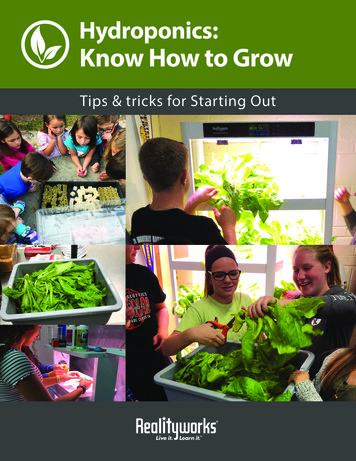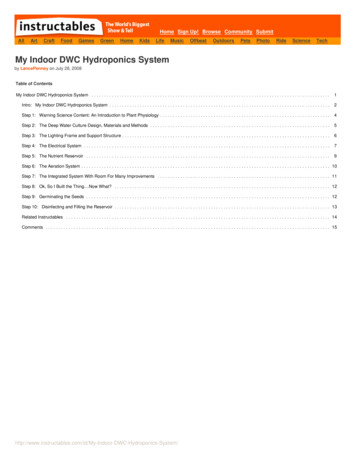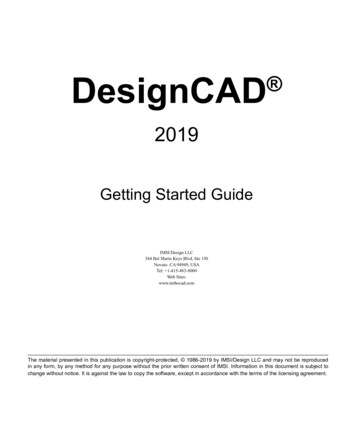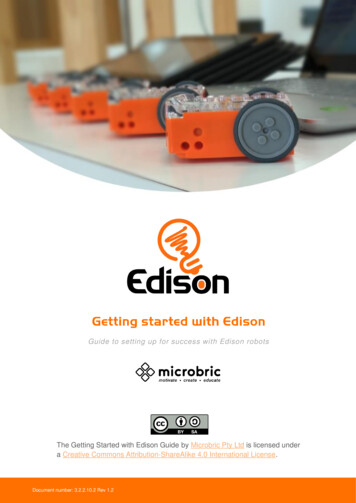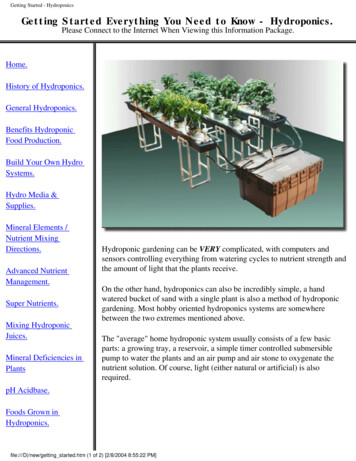
Transcription
Getting Started - HydroponicsGetting Started Everything You Need to Know - Hydroponics.Please Connect to the Internet When Viewing this Information Package.Home.History of Hydroponics.General Hydroponics.Benefits HydroponicFood Production.Build Your Own HydroSystems.Hydro Media &Supplies.Mineral Elements /Nutrient MixingDirections.Advanced NutrientManagement.Super Nutrients.Mixing HydroponicJuices.Mineral Deficiencies inPlantsHydroponic gardening can be VERY complicated, with computers andsensors controlling everything from watering cycles to nutrient strength andthe amount of light that the plants receive.On the other hand, hydroponics can also be incredibly simple, a handwatered bucket of sand with a single plant is also a method of hydroponicgardening. Most hobby oriented hydroponics systems are somewherebetween the two extremes mentioned above.The "average" home hydroponic system usually consists of a few basicparts: a growing tray, a reservoir, a simple timer controlled submersiblepump to water the plants and an air pump and air stone to oxygenate thenutrient solution. Of course, light (either natural or artificial) is alsorequired.pH Acidbase.Foods Grown inHydroponics.file:///D /new/getting started.htm (1 of 2) [2/8/2004 8:55:22 PM]
Getting Started - HydroponicsUsing CO2 Successfully.Most CommonProblems.Postharvest HandlingSystems.Debate "Organics" or"Hydroponics"HydroponicTerminologyBeginner's GrowingTips.Periodic Table ofElements.Conversion CalculationTables.Science projects.References.Visit Our WholesaleWebsite.file:///D /new/getting started.htm (2 of 2) [2/8/2004 8:55:22 PM]
New Page 4Hydroponic gardening can be VERY complicated, with computers and sensors controlling everythingfrom watering cycles to nutrient strength and the amount of light that the plants receive.On the other hand, hydroponics can also be incredibly simple, a hand watered bucket of sand with asingle plant is also a method of hydroponic gardening. Most hobby oriented hydroponics systems aresomewhere between the two extremes mentioned above.The "average" home hydroponic system usually consists of a few basic parts: a growing tray, a reservoir,a simple timer controlled submersible pump to water the plants and an air pump and air stone tooxygenate the nutrient solution. Of course, light (either natural or artificial) is also required.file:///D /new/pages/right.htm [2/8/2004 8:55:23 PM]
History of HydroponicsHistory of Hydroponics.Hydroponics basically means working water ("hydro" means "water" and "ponos" means "labor"). Manydifferent civilizations have utilized hydroponic growing techniques throughout history. As noted inHydroponic Food Production (Fifth Edition, Woodbridge Press, 1997, page 23) by Howard M. Resh:"The hanging gardens of Babylon, the floating gardens of the Aztecs of Mexico and those of the Chineseare examples of 'Hydroponic' culture. Egyptian hieroglyphic records dating back several hundred yearsB.C. describe the growing of plants in water." Hydroponics is hardly a new method of growing plants.However, giant strides have been made over the years in this innovative area of agriculture.Throughout the last century, scientists and horticulturists experimented with different methods ofhydroponics. One of the potential applications of hydroponics that drove research was for growing freshproduce in nonarable areas of the world. It is a simple fact that some people cannot grow in the soil intheir area (if there is even any soil at all). This application of hydroponics was tested during World WarII. Troops stationed on nonarable islands in the Pacific were supplied with fresh produce grown in locallyestablished hydroponic systems. Later in the century, hydroponics was integrated into the space program.As NASA considered the practicalities of locating a society on another plant or the Earth's moon,hydroponics easily fit into their sustainability plans. This research is ongoing.But by the 1970s, it wasn't just scientists and analysts who were involved in hydroponics. Traditionalfarmers and eager hobbyists began to be attracted to the virtues of hydroponic growing. A few of thepositive aspects of hydroponics include: The ability to produce higher yields than traditional, soil-based agricultureAllowing food to be grown and consumed in areas of the world that cannot support crops in thesoilEliminating the need for massive pesticide use (considering most pests live in the soil), effectivelymaking our air, water, soil, and food cleanerCommercial growers are flocking to hydroponics like never before. The ideals surrounding thesegrowing techniques touch on subjects that most people care about, such as helping end world hunger andmaking the world cleaner. In addition to the extensive research that is going on, everyday people from allover the world have been building (or purchasing) their own systems to grow great-tasting, fresh food fortheir family and friends. Educators are realizing the amazing applications that hydroponics can have inthe classroom. And ambitious individuals are striving to make their dreams come true by making theirliving in their backyard greenhouse, selling their produce to local markets and restaurants.file:///D /new/pages/history of hydroponics.htm [2/8/2004 8:55:23 PM]
General HydroponicsGeneral Hydroponics.CropsCrops produced in today's modern greenhouse ranges are many and varied. They can be looselycategorized as follows: vegetables including tomatoes, cucumbers, fancy lettuces, bell peppers, cherrytomatoes and a host of minor ones such as radish, melon and strawberrycut flowers e.g. roses, mums, carnationspotted flowers e.g. geraniums, azalea, poinsettia, tulipnumerous bedding plantsGrowing MediaPorous, well aerated substrate are used as anchorage for the plants root system and feeding area.Rockwool and Heydite are the most popular as they are most readily available, and easiest to use andtransport. There are various other mediums which are not as widely used. Click for more infoGrowing TechniquesThere are different ways to bring water to the plants. Learn more about growing techniques. Nutrient Film Technique,Drip-Irrigation or Micro-Irrigation,Aeroponics / Deep Water Culture,Flood & Drain,Home Hobbyist Systems,Passive Planters / Hydroculture.Carbon Dioxide EnrichmentIn an outdoor garden the CO2 level in the air is about 300 parts per million (ppm). Plants thrive whenthey are able to take in a higher level of CO2. Growers today monitor their greenhouse CO2 levels withspecial purpose control monitors which in turn operate CO2 burners or generators to replenish CO2consumed by the plants.HAF (Horizontal Air Flow)file:///D /new/pages/general hydroponics.htm (1 of 6) [2/8/2004 8:55:24 PM]
General HydroponicsWorking with CO2 enrichment and indeed an important part of the greenhouse environment is horizontalair flow. Conceived in the late seventies following research involving finer aspects of greenhouse aircirculation, horizontal air flow, or HAF as it is now referred to, is widely used.SecurityCommercial growers end up with very sizeable portions of their yearly turnover as work-in-process. Thecloser the crop gets to harvest, the higher the risk of catastrophic loss, should a key part of thegreenhouse's climate control system fail. Accordingly, growers go to great lengths to protect themselves.Early warning is a vital part of their security. Most now employ automatic phone dialers with electronicvoice simulation to alert them of impending problems long before serious crop damage can occur.BiologicalsEnvironmental concerns are uppermost in the minds of today's consuming public. The horticulturalindustry has been working for many years to reduce its dependence on chemical pesticides, many ofwhich have been linked to cancers. Numbers of key pesticides have been deregistered for particularcrops, others have been removed from the market altogether. Promising advances have been made in theuse of predator insects in greenhouse ranges as natural biological control against pest insects. Whilemuch work remains to be done to educate the grower in their use, progressive members of the industryare now well on their way to 100% biological insect control.Bumble BeesUntil recently, pollination of greenhouse tomato crops was accomplished with a labourious method offruit truss vibration utilizing battery operated hand-held vibrators ("electric bees") manually touchedagainst mature flower sets. It was a strictly artificial way of simulating natural pollination in the absenceof a natural outdoor environment where wind and insects are the vectors. In today's modern tomatoranges, hives of bumble bees are placed strategically amongst the crop and left to accomplish naturallywhat has been, until now a monotonous and tedious task for greenhouse staff.LightingIn order to get the best possible results from a Controlled Environment Agriculture System, we will needto bring the spectrum and intensity of sunlight indoors. This is accomplished using High IntensityDischarge lamps. These lamps, in conjunction with specially designed luminaries, will reflect lightdownwards to plants, where it may be utilized to the maximum. Click for more info.Climate ControlsModern greenhouses employ advanced environment control aids such as relays, humidistats, thermostats,file:///D /new/pages/general hydroponics.htm (2 of 6) [2/8/2004 8:55:24 PM]
General HydroponicsCO2 injection systems and fans which are often controlled by a central computer. Smaller systemsemploy various individual control units.BioponicsThe organic hydroponic display or Bioponics, we believe, is of significant interest to both commercialand hobby growers. This method employs an organic tea based nutrient solution with added microbialagents to facilitate their breakdown into mineral elements which plants are able to take in.Controlled EnvironmentAgriculture SystemsCommercial StructuresToday's commercial greenhouses are constructed of galvanized steel, extruded aluminum, fibreglass,polycarbonate, acrylic, polyethylene and glass. The percentage of each, comprising a typical structure,varies by type of design.Loosely categorized, the following basic shapes and styles are prevalent: freestanding grade to grade hoop houses (quonset) clad inpolyethylene, double polyethylene, corrugated fibreglass sheet, orplastic composite structured panelslinked or gutter-connected straight-wall hoop houses clad inpolyethylene, double polyethylene and so on as abovelinked or gutter-connected straight-wall hoop houses clad incurved automotive glasslinked or gutter-connected straight-wall peaked houses clad in flattempered glass. This style of range breaks down into three further subcategories:- single peak gutter-to-gutter- double peak with floating gutter- triple peak with two floating guttersAll of the above styles or designs of greenhouses are popular, the grower selecting which he will buildbased on crop to be grown, usage pattern, seasonal pattern, as well as economic considerations. Nutrient control insures that the plants get the minerals they need at the right pH and temperature.Faster growth then soil grown plants.No weeds. The medium is mostly inert and unless it is out doors, there is no way for weed seedsto get into the growing medium.file:///D /new/pages/general hydroponics.htm (3 of 6) [2/8/2004 8:55:24 PM]
General Hydroponics No guess work about what nutrients are going to the plant.Easy to correct for plant deficiencies.No backbreaking soil conditioning.The water has all the nutrients that is required by the plants. The roots don't have to grow biggerlooking for food. The growth of the plant goes mostly to the upper plant.Plants can be spaced closer together then in soil. Spacing is dependent only on the space neededto supply adequate light to the plant.Garden can be at a good working height.Up to twenty times the amount of plants can be grown in the same space in hydroponics then insoil.No soil to harbor bugs.Healthy plants have better taste.Healthy plants resist insect infestations. Less insecticide is needed.Educational for children of all ages learning about plant growth.Faster growth so that more then one crop can be raised in a season.Can be made portable so that you can move it from classroom to classroom or take it with youwhen you move.Ground is left undisturbed on rented property.Condensed growing methods make better use of greenhouse space.Consumes 1/10 the water that field crops do.Conversation piece.Good past time for those that likes to tinker.It's something the Jones' don't have. :-)Some disadvantages to growing plants in hydroponics are; Higher cost to get started then soil culture.System failure could result in a lost crop if not caught right away. Some systems can go daysbefore damage occurs.Watering MethodsAll the plants needs are supplied by water. The roots are placed in an inert growing medium. Water,enriched with all the nutrients the plants need, is supplied to the roots by several different methods.1. Aeroponics; the roots are sprayed with the nutrient solution. This method ensures that the rootsget plenty of oxygen to the root system. It has not been proven that this method helps to makeplants grow any faster then in other methods. It has some inherent problems such as nozzlesgetting plugged up. One of the more expensive methods of hydroponics.file:///D /new/pages/general hydroponics.htm (4 of 6) [2/8/2004 8:55:24 PM]
General Hydroponics2. Ebb and flow; also called flood and drain. Periodically floods the medium. As the water drains outnew air comes in. Not as hard to maintain as an aeroponics system. Roots can plug up waterwayshowever.3. NFT; the Nutrient Film Technique is one of the methods most often used by commercial growers.Plant roots are contained in a channel through which a thin "film" of nutrient solution passes. Thenutrient solution is aerated and recycled with the addition of makeup water.4. Run to waste; in this method the nutrient is fed to the plants at near the same rate as the plants usethe water. In all the other methods, the nutrient solution returns to a tank to be recycled. Thissystem is the cheapest to get started, however, it requires a lot of monitoring to insure the plantsare getting enough nutrient but at the same time not getting too much nutrient. Plants will onlytake up the nutrients it needs. On sunny days they take up mostly water and leave the nutrientsbehind to build up. The built up salts must be purged from the system one or two times a week.This system wastes the most nutrients.SystemsPlants most generally have to be stared in a small amount of medium before they can be placed in thegrowing area. Seeds are started with no nutrients in the water. Seeds have their own food and don'trequire any additional nutrients until the first set of leaves appear. Nutrient is added at half strength toencourage root development until it's transplanted. Then full strength nutrients are used for the rest of theplants growth. There are two kinds of formulas for plants. One promotes the vegetative growth and theother promotes Fruiting. A system that has both types of plants will have to have one or the otherformulas depending on which crop is more important. There are two methods of growing systems,horizontal and vertical. The following are systems: Bag culture; used commercially in run to waste systems. The hobbyiest can also use thisinexpensive method in a recirculating system. Bags are filled with a lightweight medium andnutrient is fed to each bag by inexpensive spaghetti tubes. Has the advantage of being able tospace the plants as they mature. Tomatoes in bag culture.Gutter/NFT; A lot of hobbyiests have tried just about everything with this type system.1. Manufactured channels; Square corners help to prevent damming.2. Rain gutter; Metal gutter can oxidize and add undesirable materials to the nutrientfile:///D /new/pages/general hydroponics.htm (5 of 6) [2/8/2004 8:55:24 PM]
General Hydroponicssolution. Line with plastic sheet. Plastic gutters require total support to keep itstrait.3. PVC pipe; most hobbyiests use PVC pipes with holes drilled for plants. This systemis usually more expensive then bag culture. Too often the roots clog up thewaterways and dam the water causing root rot. Aeration in the root zone maybecome a problem. Beds; are extra wide channels. Beds can be filled with a growing medium or pots can be placed inthe bed so that they will pick up the water from the bed through a wicking action. Pots are themost versatile. Plants can be spaced to meet the plants needs. I use this method for houseplantsand for starting seeds. A 1/4 inch of water can be maintained in beds with pots. Water must bedrained well in filled beds. Beds can be made from any material that will hold the weight of theplants and the medium. A plastic film can be used to line construction. Nutrient solution is usuallyaerated and returned to the bed.file:///D /new/pages/general hydroponics.htm (6 of 6) [2/8/2004 8:55:24 PM]
Although there is no soil in a hydroponic gardenAlthough there is no soil in a hydroponic garden, the plants must still beanchored. There is a wide range of inert materials which can be used tosupport plant roots and we call them "growing mediums".Heydite, clay pellets, Perlite, vermiculite, and Rockwool are the mostpopular media. The hydroponic media that work best are pH neutral,provide ample support for plants, retain moisture, and allow space for goodair exchange. The type of media you choose will depend on the size andtype of plants you wish to grow, and the type of hydroponic system beingused.For continuous drip systems, course media such as Heydite (a porousshale) or Hydrocorn (clay pellets) are best. The 1/4 " to3/4 " pebblesprovide enough free drainage and air space to take advantage ofcontinuous feeding. These media also provide good anchorage for largerplants, and are easy to clean and re-use indefinitely.Rockwool is also another popular medium. Made from rock which has been meltedand spun into fibrous cubes and growing slabs with the texture of insulation,Rockwool provides roots with a good balance of water/oxygen. Small cubes areused for starting seeds and cuttings, 3" or 4" cubes for small plants or intermediategrowth, and slabs for larger plants. Rockwool can be used with continuous drip orflood and drain systems. Although it is possible to sterilize and re-use Rockwool,most often it is used only once.Perlite, made from volcanic rock, is a white, light weight material often used as a soil additive. The 1/8"to 1/4" pellets can be used alone as growing medium, but don't provide enough anchorage for largeplants. Perlite is often used to start seed and cuttings, which can easily transplanted after rooting.Vermiculite is use the same way as Perlite, and the two are sometimes mixed together. It is made fromheat expanded mica and has a flaky, shiny appearance. Soilless mix such as Pro-mix BX, and Pro-mixlite has the appearance and texture of light soil. Mainly peatmoss, mixed with Perlite, it contains verylittle nutrient, and is used a a soil additive, or alone as a hydroponic medium.file:///D /new/pages/hydro media.htm (1 of 2) [2/8/2004 8:55:24 PM]
Although there is no soil in a hydroponic gardenSome hydroponic systems do not require any growing medium at all. Various methodsare used to support the plants while the roots are directly fed nutrient solution. Someexamples of these are, aeroponic, N.F.T., or "Nutrient Film Technique" and deepwater culture.file:///D /new/pages/hydro media.htm (2 of 2) [2/8/2004 8:55:24 PM]
Growing TechniquesGrowing TechniquesBeginner's Growing Tips.Nutrient Film Technique.The purist form of today's highly developed hydroponic growing systems is Nutrient Film Technique(N.F.T.). It is also the form of hydroponics most intriguing to the public because of its futuristic natureand appearance.The nutrient is fed into growtubes where the roots draw it up. The excess drains by gravity back to thereservoir. A thin film of nutrient allows the roots to have constant contact with the nutrient and the airlayer above at the same time.Drip-Irrigation or Micro-IrrigationToday's greenhouse irrigation systems employ, to an ever-increasing extent, the concept of drip or microirrigation. It entails a principle of minimized water consumption with maximized plant benefit. There areliterally hundreds of emitting/dripping/trickling/micro-spraying/etc. devices on the market today for thecommercial/hobbyist grower to choose from.A submersed pump feeds nutrients solution through header tubes to secondary feed lines connected todrip emitters.A controlled amount of solution is continuously drip-fed over the medium and root system. Another tubeis connected to the lower part of the garden system to recover the solution.Aeroponics / Deep Water CulturePlant roots are suspended in highly oxygenated nutrient solution allowing easy inspection and pruning ofroots. Air pumps, compressors or Oz injectors provide oxygen which is crucial to healthy plant growth.The simplicity and affordability of these very active systems make them popular with home hobbyistsand commercial growers alike.In an Aeroponic system the roots are misted within a chamber. A pump pushes the water with nutrientsolution through sprayers, keeping the roots wet while providing a maximum amount of oxygen.This technique is an excellent way to propagate cuttings.Deep Water Culture is another form of aeroponics. The root system of a plant grown in Deep Waterfile:///D /new/pages/growing techniques.htm (1 of 2) [2/8/2004 8:55:24 PM]
Growing TechniquesCulture is immersed in water with a bubbling aerator keeping the roots oxygenated.This technique is very good to use with plants that are heavy feeders.Flood & DrainFlood & Drain systems are similar to N.F.T. systems. They are ideal for multiple plant per square footgrowing where individual plant inspection is difficult. They are also very popular as propagation tables.A plastic growing tray is flooded periodically by a submersed pump connected to a digital timer (or theControlFreak!). Medium and root system are soaked, then drained (via gravity back through the pump) atspecific intervals.Various mediums can be used, Rockwool is the most popular with Flood & Drain systems.The Ebb & Flow trays are examples of the Flood & Drain system.Home Hobbyist SystemsThere are a number of compact hydroponic systems and kits most popular with home hobbyists,researchers and teachers. These are made to be especially attractive to children in order to get theirattention and interest. Hobby systems include deep water and aeroponic systems which are scaled downversions of commercial systems.Passive Planters / HydrocultureThis is probably the most commonly know form of hydroponics. These systems do not require a water orair pump and are therefore called passive systems. Passive Planters have been used in office buildingsand restaurants for many years.Hydroculture planters utilize a clean, porous growing medium to support plant roots. A nutrient reservoirin the base of the growing container allows the plants to take as much or as little water as they require.Water level indicators show exactly when and how much to water. Clean, odourless and non-allergenic,hydroculture or passive planters are ideal for every environment.file:///D /new/pages/growing techniques.htm (2 of 2) [2/8/2004 8:55:24 PM]
BeginnerBeginner's Growing Tips.Growing Tips From the Experts.This page has been designed to help answer the important questions beginning growers might have whenjust getting started in hydroponics. A lot of these concepts are connected to each other. Follow the linksand put the pieces of this growing puzzle together.The more you know, the easier it is to grow!Carbon DioxideDuring photosynthesis, plants use carbon dioxide (CO2), light, and hydrogen (usually water) to producecarbohydrates, which is a source of food. Oxygen is given off in this process as a by-product. Light is akey variable in photosynthesis.ConductivityMeasuring nutrient solution strength is a relatively simple process. However, the electronicdevices manufactured to achieve this task are quite sophisticated and use the latest microprocessortechnology. To understand how these devices work, you have to know that pure water doesn’tconduct electricity. But as salts are dissolved into the pure water, electricity begins to beconducted. An electrical current will begin to flow when live electrodes are placed into thesolution. The more salts that are dissolved, the stronger the salt solution and, correspondingly, themore electrical current that will flow. This current flow is connected to special electronic circuitrythat allows the grower to determine the resultant strength of the nutrient solution.The scale used to measure nutrient strength is electrical conductivity (EC) or conductivity factor(CF). The CF scale is most commonly used in hydroponics. It spans from 0 to more than 100 CFunits. The part of the scale generally used by home hydroponic gardeners spans 0-100 CF units.The part of the scale generally used by commercial or large-scale hydroponic growers is from 2 to4 CF. (strength for growing watercress and some fancy lettuce) to as high as approximately 35 CFfor fruits, berries, and ornamental trees. Higher CF values are used by experienced commercialgrowers to obtain special plant responses and for many of the modern hybrid crops, such astomatoes and some peppers. Most other plant types fall between these two figures and themajority is grown at 13-25 CF.--Rob SmithGerminationfile:///D /new/pages/beginner.htm (1 of 15) [2/8/2004 8:55:26 PM]
BeginnerWhen a seed first begins to grow, it is germinating. Seeds are germinated in a growing medium, such asperlite. Several factors are involved in this process. First, the seed must be active--and alive--and not indormancy. Most seeds have a specific temperature range that must be achieved. Moisture and oxygenmust be present. And, for some seeds, specified levels of light or darkness must be met. Check thespecifications of seeds to see their germination requirements.The first two leaves that sprout from a seed are called the seed leaves, or cotyledons. These are not thetrue leaves of a plant. The seed develops these first leaves to serve as a starting food source for theyoung, developing plant.Growing MediumSoil is never used in hydroponic growing. Some systems have the ability to support the growing plants,allowing the bare roots to have maximum exposure to the nutrient solution. In other systems, the rootsare supported by a growing medium. Some types of media also aid in moisture and nutrient retention.Different media are better suited to specific plants and systems. It is best to research all of your optionsand to get some recommendations for systems and media before making investing in or building anoperation. Popular growing media include: Composted bark. It is usually organic and can be used for seed germination.Expanded clay. Pellets are baked in a very hot oven, which causes them to expand, creating aporous end product.Gravel. Any type can be used. However, gravel can add minerals to nutrient. Always make sure itis clean.Oasis. This artificial, foam-based material is commonly known from its use as an arrangementbase in the floral industry.Peat moss. This medium is carbonized and compressed vegetable matter that has been partiallydecomposed.Perlite. Volcanic glass is mined from lava flows and heated in furnaces to a high temperature,causing the small amount of moisture inside to expand. This converts the hard glass into small,sponge-like kernels.Pumice. This is a glassy material that is formed by volcanic activity. Pumice is lightweight due toits large number of cavities produced by the expulsion of water vapor at a high temperature aslava surfaces.Rockwool. This is created by melting rock at a high temperature and then spinning it into fibers.Sand. This medium varies in composition and is usually used in conjunction with anothermedium.Vermiculite. Similar to perlite except that it has a relatively high cation exchange capacity-meaning it can hold nutrients for later use.There are a number of other materials that can (and are) used as growing media. Hydroponic gardenerstend to be an innovative and experimental group.file:///D /new/pages/beginner.htm (2 of 15) [2/8/2004 8:55:26 PM]
BeginnerHydroponic SystemsThe apparatuses used in hydroponic growing are many and varied. There are two basic divisions betweensystems: media-based and water culture. Also, systems can be either active or passive. Active systemsuse pumps and usually timers and other electronic gadgets to run and monitor the operation. Passivesystems may also incorporate any number of gadgets. However, they to not use pumps and may rely onthe use of a wicking agent to draw nutrient to the roots.Media-based systems--as their name implies--use some form of growing medium. Some popular mediabased systems include ebb-and-flow (also called flood-and-drain), run-to-waste, drip-feed (or top-feed),and bottom-feed.Water culture systems do not use media. Some popular water culture systems are raft (also called floatingand raceway), nutrient film technique (NFT), and aeroponics.LightThink of a plant as a well-run factory that takes delivery of raw materials and manufactures the mostwondrous products. Just as a factory requires a reliable energy source to turn the wheels of its machinery,plants need an energy source in order to grow.Artificial LightUsually, natural sunlight is used for this important job. However, during the shorter and darkerdays of winter, many growers use artificial lights to increase the intensity of light (forphotosynthesis) or to expand the daylight length. While the sun radiates the full spectrum(wavelength or color of light) suitable for plant life, different types of artifi
Getting Started - Hydroponics Getting Started Everything You Need to Know - Hydroponics. Please Connect to the Internet When Viewing this Information Package. Home. History of Hydroponics. General Hydroponics. Benefits Hydroponic Food Production. Build Your Own Hydro Systems. Hydro Media &
